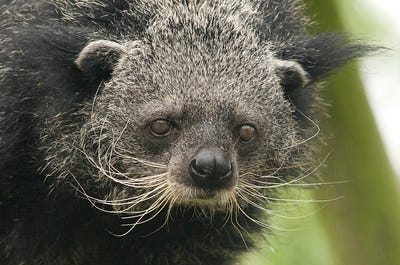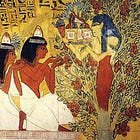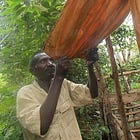Planet Ficus Monthly Roundup #2
Chinese temples. Bornean binturongs. A living goddess. Medicinal figs. Citizen science. Hiding soldiers.
Each month, I’ll bring you stories from around the world that reveal just how extraordinary fig trees are — not just biologically, but culturally, spiritually and artistically.
In this roundup, you’ll find sacred fig trees protected in India, medicinal breakthroughs from wild figs, a quest for citizen scientists, Chinese temple trees, Bornean binturongs sowing fig gardens in the treetops, a curious story about Japanese soldiers — and much more.
This variety is not random — it’s evidence that fig trees are everywhere in the human story and central to many ecosystems and cultures.
My mission with these roundups is simple: To show you that fig trees are the most interesting, important and awe-inspiring plants on the planet. Thanks for joining me on this journey. I hope these stories surprise and delight you, and maybe even change the way you see the natural world.
Let’s dive in.
Biodiversity, Ecology and Conservation
Indian Prime Minister Narendra Modi planted a fig tree to mark World Environment Day on 5 June. The tree is a banyan (Ficus benghalensis) — a type of strangler fig that sustains dozens of species of fruit-eating animals and is culturally significant in India. Modi’s tree will form part of a large-scale tree planting initiative.
Buddhist and Taoist temples across China play a key role in protecting ancient and endangered tree species, including thousands of fig trees, according to research published in the science journal Current Biology.
Naturalist Quentin Phillipps shared photos from Borneo, where tree climbers scaled 50 metres into the canopy to install cameras to monitor animals feeding on Ficus dubia figs. There, they found signs of the binturong, a shaggy, fig-loving mammal that is an important seed disperser. As Quentin poetically puts it, binturongs: “wipe their sticky bottoms by pasting their dung onto a mat of leafy epiphytes once they have finished feeding… thereby sowing the seeds of a sky fig garden for the future benefit of their offspring and the fig eating wildlife.”

Fig Tree Pharmacies
Several new studies have investigated potential health benefits that wild fig species could one day provide us. One suggests that an extract of the bark of a strangler fig called Ficus virens could protect against alcohol-induced gastric ulcers. Another found that extracts from leaves of an African fig tree called Ficus capensis have promise for treating malaria. A third study showed that leaf extracts from the edible fig (Ficus carica) may support skin wound healing.
Around the world, people have used the bark, leaves, sap and roots of fig trees in traditional medicines for thousands of years. New publications reviewing research on these medicinal uses of fig trees include academic book chapters on the cluster fig (Ficus racemosa), the banyan (Ficus benghalensis) and the weeping fig (Ficus benjamina), and a similar study on the Chinese banyan (Ficus microcarpa).
Sacred Trees, Rituals and Belief
In India, the website Patrika.com reported the story of Susheel Giddiya and his family, who live in a three-storey house built around a giant fig tree. Walk into the kitchen and you could easily trip over the huge branch that is growing up through the floor and out of one of the walls. The tree is a Ficus religiosa. As its name suggests, this species is revered. Mr Giddiya says his family built around the tree rather than cutting it down—because they believe deities live within it.
Staying in India, the state of Bihar has added several special fig trees to its list of protected heritage trees. Among them is a giant 500-year-old banyan (Ficus benghalensis) that local people say is a living goddess. Pilgrims travel long distances to pray beneath it. A belief that blindness will afflict anyone who cuts a branch of the tree has helped it to survive and spread over an acre (0.4 hectare). With its new heritage status, the tree will receive care from experts and even a monthly pension.
Cultivated Figs and Human Use
There are more than 900 species of fig trees, but one species is itself super-diverse. Ficus carica — the domesticated or edible fig — has thousands of distinct varieties. Andrea Graham is on a mission to identify all the varieties that people from around the world have brought to New Zealand, which has no native figs of its own. As Mei Leng Wong reports, Graham is enlisting citizen scientists to grow fig trees from cuttings she has collected from across the country. As there are nearly 200 local names for what are probably about 60 different fig varieties, Graham wants to bring clarity to this biodiversity and protect it.
Figs in Culture, Art and Storytelling
Kenyan writers used the impressive stature of the mugumo fig tree (Ficus thonningii) to describe literary giant Ngugi wa Thiong’o, who recently passed away. Kimani Njogu referred to him as "the great mugumo tree of African literature". Odilia Anyachi Okonga said: “The mighty mugumo tree has fallen, but its roots still nurture us”. As forthcoming Planet Ficus stories will show, mugumo trees have many important roles in Kenyan history and culture.
When World War II ended, two Japanese soldiers on a remote island off Okinawa did not get the message. They spent the next two years living in the canopy of a big strangler fig hoping to avoid detection by US troops. As Maika Hyuga reports, a new movie called ‘Ki no ue no Guntai’ tells their story.

Ancient Traditions
Pankaj Mishra interviewed Morningstar Khongthaw, the man keeping alive a centuries-old tradition of creating living bridges from the roots of Ficus elastica fig trees in northern India — see my story on the bridges.
At the heart of villages across India you will find a stone platform built around the base of a tree (usually a fig species). As well as supporting many species of wildlife, the tree provides shade for markets and meetings. It is a central place for conversation and community. But as three scientists writing for Down to Earth explained, the trees and their platforms are falling victim to urbanization. They call for policies and actions to map, study and protect these trees and the social and ecological benefits they provide.
Over To You
Do you have a memory, photo, or observation involving fig trees? I’d love to hear from you. Send your story or image to planetficus@substack.com — I’ll feature selected entries in future editions. Thanks for reading!






